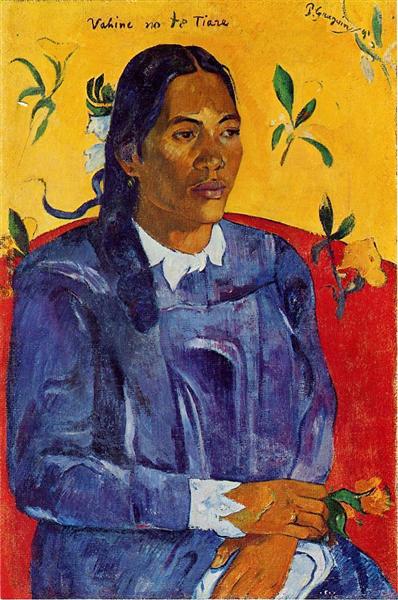Description
Paul Gauguin's 1891 painting "Woman with a Flower" stands out as an exemplary work of symbolism and post-impressionism, styles the artist adopted in his search for a deeper expression of life and culture. This portrait captures a Polynesian woman, presented in the fleeting moment of contemplation, with an air of serenity and mystery typical of many of Gauguin's depictions of women.
Compositionally, the work displays a balanced disposition that highlights the central character. The woman appears in the foreground, occupying almost the entire length of the canvas, while a simple, softly tonal background, characterized by a light chiaroscuro, allows the viewer to focus on her figure. The position of the woman, who turns her head slightly to her left, accentuates the feeling of introspection, as if she were in a moment of deep connection with her surroundings or her own thoughts. This pose also invites the observer to enter her personal world, generating an emotional bond that is typical of many of Gauguin's works.
Color plays a fundamental role in this work. Gauguin uses a vibrant palette, where warm and earthy tones predominate—greens, yellows and browns—that suggest the natural abundance of Tahiti, where the artist lived and was inspired. The pure white flower that the woman holds contrasts with the richness of the colors of the background and her dress, which not only enhances the form, but also symbolizes the ephemeral beauty and fragility of femininity. This floral element is recurrent in the symbolism of the painting, since in many cultures it is associated with love and life, and invites us to reflect on the interactions between nature and humans.
Female faces and figures are a constant in Gauguin's work, as the artist focused much of his interest on the depiction of women, especially those he encountered on his travels to the Pacific Islands. The women in his work are often depicted with an almost mythical essence, endowed with a dignity and presence that transcends simple representation. In this specific work, the woman is not just a portrait; she is a symbol of the connection between the individual and their natural environment, as well as indicative of Gauguin's focus on exploring cultural and sexual identity.
Gauguin is known for breaking away from more traditional methods of representation, using simplification of forms and juxtaposition of colours that were previously considered inharmonious. This technique not only reflects the influence of folk and primitive art in his work, but also reveals his desire to move away from the realism of his time and explore more subjective expressions of human experience.
In the context of his career, Woman with a Flower is emblematic of a period in which Gauguin sought to move away from the demands of European urban life and find artistic purity in the simpler, more natural life of indigenous cultures. This painting, beyond its aesthetic beauty, raises questions about perception and cultural experience, and adds to the exploration of the meaning of the representation of the other in art, a theme that continues to be relevant in contemporary criticism.
In conclusion, “Woman with a Flower” is not just a portrait; it is a window into the world of Paul Gauguin, reflecting both his obsession with Polynesian beauty and culture, and his desire to approach a more authentic and meaningful art form. Through his use of color, composition, and depiction of the female figure, Gauguin invites us to contemplate not only the depicted subject, but also the complex interactions between art, nature, and the essence of life itself.
KUADROS ©, a famous painting on your wall.
Hand-made oil painting reproductions, with the quality of professional artists and the distinctive seal of KUADROS ©.
Painting reproduction service with satisfaction guarantee. If you are not completely satisfied with the replica of your painting, we will refund 100% of your money.

